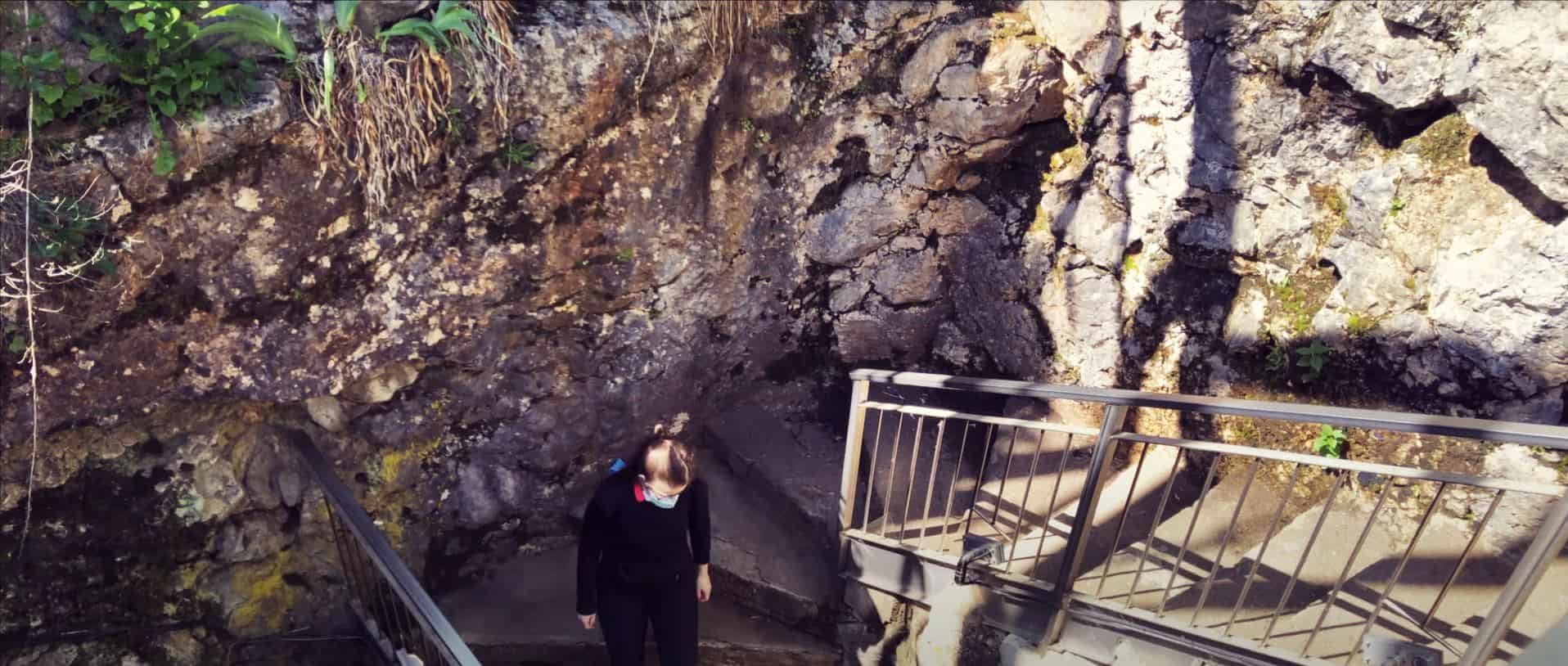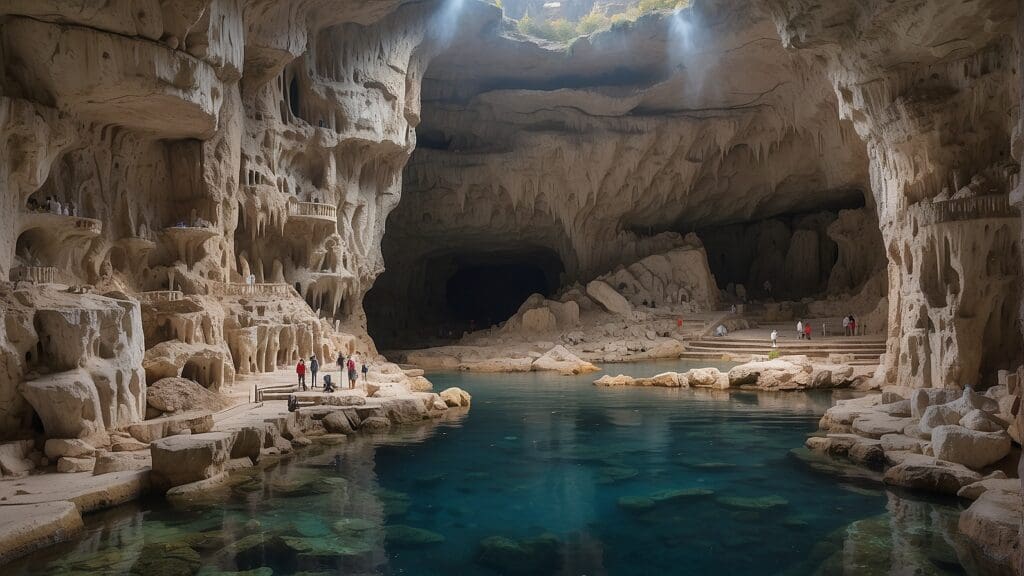Grotta Gigante – Trieste – Italy

Updated On: February 26, 2024 by Ahmed Samir
There’s something for everyone in this sun-soaked city of Trieste – Italy. If you are a daredevil, be ready to join us in exploring Grotta Gigante, one of the most thrilling caves in the world filled with archaeological marvels.
Beneath the picturesque landscapes of Trieste, Italy, lies an underground realm that defies imagination and beckons to the adventurous at heart. Grotta Gigante, aptly named the “Giant Cave,” is an awe-inspiring testament to the Earth’s hidden wonders. With its monumental chambers, intricate stalactite formations, and an enchanting history that spans millennia, Grotta Gigante is a natural treasure waiting to be explored and celebrated.
In this extensive exploration of Grotta Gigante, we embark on a journey into the heart of this underground wonderland. We will delve into the cave’s geological origins, the breathtaking stalactites and stalagmites that grace its chambers, its intriguing history, and the immersive experiences it offers to modern-day visitors. Prepare to be captivated by the mystery and majesty of Grotta Gigante, a marvel of nature that has fascinated and inspired generations of adventurers and scientists alike.
Geological Origins
Grotta Gigante owes its existence to the intricate dance of water and limestone that has unfolded beneath the Earth’s surface for millions of years. This mesmerizing underground labyrinth results from karstic processes, where water slowly dissolves the soluble limestone rock, carving out intricate passages and chambers.
The cave’s formation began during the Upper Cretaceous period, approximately 70 million years ago, when the area was submerged under a shallow sea. Over millions of years, sediments, shells, and marine organisms accumulated, forming layers of limestone. The limestone was exposed to the elements as the sea retreated, and the dissolution began.
Rainwater, enriched with carbon dioxide, seeped through the Earth’s surface, creating a weak carbonic acid solution. This acidic water gradually dissolved the limestone, enlarging cracks and cavities. As the process continued, it gave birth to the vast underground network of passages and chambers that we now know as Grotta Gigante.
The enormous underground chambers of Grotta Gigante are primarily the result of the collapse of massive cave vaults, creating a series of awe-inspiring voids beneath the surface. The largest chamber, aptly named “La Sala Grande” (The Big Hall), is an astonishing 107 meters long, 65 meters wide, and 98 meters high – an immense expanse that could easily accommodate the Milan Cathedral.
Stalactites and Stalagmites
One of the most enchanting features of Grotta Gigante is the rich tapestry of stalactites and stalagmites that adorn its chambers. These breathtaking formations are created through the slow deposition of calcium carbonate-rich water from the cave’s ceiling onto the cave floor.
Stalactites, which hang like icicles from the cave ceiling, are formed as water droplets containing dissolved calcium carbonate seep through the limestone rock. As these droplets release carbon dioxide into the cave air, calcium carbonate precipitates, layer by layer, creating the elongated formations we admire today.
On the other hand, stalagmites rise from the cave floor, growing upwards as they accumulate water deposits dripping down from above. When stalactites and stalagmites meet, they form impressive columns, and Grotta Gigante boasts some of the most spectacular examples of these natural wonders.
The delicate and intricate formations within Grotta Gigante are a testament to nature’s slow and patient work. Over millennia, these structures have evolved, creating a surreal and magical environment that transports visitors to an otherworldly realm.
History and Exploration
Grotta Gigante’s exploration history is as rich and intriguing as the cave itself. Its discovery can be traced back to the early 19th century when the cave was known to locals but remained largely unexplored. In 1840, the cave’s entrance was officially recorded and named “Grotta di Brisciachi.”
However, the actual exploration of Grotta Gigante began in the early 20th century, thanks to the efforts of two speleologists, Andrea Perko and Lazar Widmar, who hailed from Slovenia. In 1908, they embarked on a daring expedition into the cave’s depths, armed with nothing but rudimentary equipment and their boundless curiosity.
The explorations of Perko and Widmar marked the beginning of scientific study within Grotta Gigante. They mapped the cave’s passages and documented its geological formations, contributing significantly to our understanding of this subterranean marvel.
During World War I, the cave was a refuge for locals and soldiers, its vast chambers providing shelter from the conflict raging above ground. It was only after the war that exploration resumed in earnest, and in 1920, the cave was officially named “Grotta Gigante” due to its monumental size.
In the following decades, Grotta Gigante continued to attract explorers and researchers from around the world. Numerous expeditions added to our knowledge of the cave’s geology and biodiversity. One of the most important discoveries was the “Grotto’s Proteus” (Proteus anguinus), a mysterious blind cave salamander unique to the karst region.
Modern-Day Exploration and Tourism

Today, Grotta Gigante remains an active hub of scientific research and exploration. The cave’s management has firmly committed to preserving its natural beauty while facilitating access for scientists and tourists.
Visiting Grotta Gigante is a remarkable journey into the heart of the Earth. The cave has walkways, lighting, and informative displays, ensuring visitors a safe and informative experience. Guided tours are available, led by experienced guides who provide insights into the cave’s geological history, biodiversity, and cultural significance.
Exploring the cave’s chambers is an awe-inspiring experience, as visitors are treated to a breathtaking display of stalactites, stalagmites, and unique rock formations. The tour’s highlight is undoubtedly the visit to La Sala Grande, where the sheer size and grandeur of the chamber leave visitors in a state of wonder.
In addition to its geological wonders, Grotta Gigante is home to a remarkable underground garden featuring rare and delicate cave-adapted flora. This subterranean oasis is a testament to the resilience and adaptability of life in extreme environments.
Education and Research
Grotta Gigante is a tourist attraction and a hub for scientific research and education. The cave’s management actively collaborates with universities and research institutions, providing a unique setting for geologists, biologists, and environmental scientists to conduct experiments and investigations.
One of the ongoing research efforts within Grotta Gigante is the study of the Proteus salamander. This unique amphibian, often called the “cave dragon,” is entirely adapted to life in dark underground environments. Its study has provided valuable insights into the evolution and adaptation of life in extreme conditions.
The cave’s educational programs offer school groups and aspiring scientists the opportunity to learn about geology, biology, and cave ecosystems firsthand. Students can better understand the intricate processes that shape the Earth’s underground landscapes through guided tours and workshops.
Preservation and Sustainability
Preserving Grotta Gigante’s delicate ecosystem is of paramount importance. The cave’s management takes extensive measures to protect its unique geological formations and biodiversity. Strict guidelines are in place to minimize the impact of tourism and scientific activities on the cave environment.
Efforts are made to monitor and control humidity and temperature levels within the cave to ensure the well-being of its fragile ecosystems. Visitors must follow established guidelines to minimize human impact, such as not touching or disturbing the cave formations.
The sustainability of Grotta Gigante extends beyond the cave itself. The surrounding area is designated as a protected natural park, safeguarding the karst landscape and its unique flora and fauna. The park’s commitment to conservation ensures that future generations will have the opportunity to marvel at this geological wonder.
Last Words
Grotta Gigante, the Giant Cave of Trieste, Italy, is a testament to the power and beauty of nature. This subterranean masterpiece, carved by millions of years of geological processes, has fascinated explorers, scientists, and tourists for generations. With its colossal chambers, intricate stalactites, and storied history, it is one of the world’s most awe-inspiring natural wonders.
The cave’s exploration and scientific study have shed light on the Earth’s hidden depths, providing valuable insights into the processes that shape our planet. Grotta Gigante’s commitment to education and conservation ensures that it remains a source of wonder and inspiration for future generations.
As you stand within the hallowed chambers of Grotta Gigante, surrounded by the ancient formations that have evolved over aeons, you can’t help but feel a deep connection to the Earth’s history. It is a place where science and beauty converge, the mysteries of the underground world are unveiled, and the wonders of nature continue to inspire all who venture into its depths.
FAQs
What is the experience for tourists visiting Grotta Gigante today, and what can they expect during a guided tour?
Visitors can expect an awe-inspiring experience with guided tours that provide insights into the cave’s geological history, biodiversity, and cultural significance. The tours are designed to be safe and informative, with walkways, lighting, and educational displays.
What measures are in place to protect and preserve the delicate cave ecosystem and its unique formations?
Strict guidelines are in place to minimize the impact of tourism and scientific activities on the cave environment. Efforts to monitor and control humidity and temperature levels within the cave ensure the preservation of its fragile ecosystems.
Are there any nearby attractions or activities that visitors can combine with visiting the cave?
The surrounding natural park offers opportunities for hiking, exploration, and enjoying the karst landscape. Trieste is a beautiful coastal city with a rich cultural heritage, making it an ideal destination for combining cave exploration with other leisure activities.






